Copywriting is an art.
When you’re writing copy, think of yourself like Picasso or Leonardo Da Vinci.
However, there’s another side of the coin: psychology.
Copywriting has many psychological components that make customers tick.
Specific words and strategic phrases are enough to make a customer whip out their credit card, call you, or book a meeting.
But, what are they? And how can you use them?
Keep reading to see. 👇
Copywriting psychological triggers
These are some of the most effective psychological triggers in copywriting you can begin applying today.
Try them for yourself.
1. Poke at their pain points
Every customer wants to buy a product for one single reason…
And, that problem has symptoms.
For example, look at the product description for this hair loss supplement:
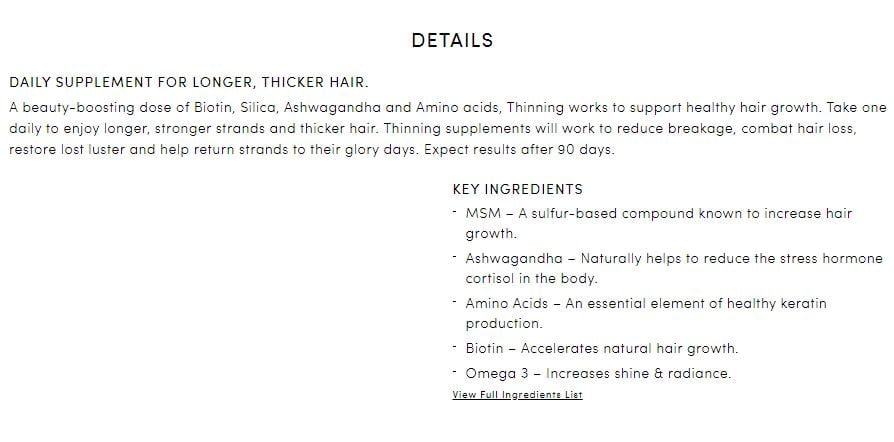
It mentions various symptoms that the customer would be experiencing, such as:
- Thinning hair
- Hair loss
- Lost luster
- Hair being healthier in the past
A customer reading this copy would relate the writing and be more likely to take action.
This is not only because clearly the product is right for them, but also because it creates emotion.
In the case of something like hair loss, it’s tied to self-image, confidence, and self-esteem.
Thus it’s going to be an emotional experience for the customer from start to finish.
Copywriters take advantage of this psychological trigger by clearly identifying the symptoms of a customer’s problem and positioning a product as the cure.
2. Create a common enemy
Humans love being on teams and fighting for a cause.
It makes us feel supported and that we’re making the right decision.
Think of politics or sports. Some times you can’t tell them apart!
Both parties are yelling for the other team to win. 😂
It’s also a powerful copywriting trigger.
Creating a common enemy for you and readers to team up against builds trust and loyalty.
Not only that, but opposition implies a pain point—as I spoke about in the first section.
That person or group is causing the customer discomfort or some sort of problem. And, together, you can take them down and come out on top!
After all, all humans are wired to avoid pain on a neurobiological and psychological level according to a study from Frontiers in Behavioral Neuroscience.
A great example is the advertising battle that car manufacturers Audi and BMW had in the past.
They are two luxury brands with similar customer bases, so naturally, they’ve been butting heads.
In previous campaigns, both brands poked at each other like this:

Audi and BMW would make advertisements that subtly mocked one another’s performance and achievements.
And, what does that do?
Create an enemy!
Audi customers would see that advertisement and think “Yeah, let’s get em’!” while BMW owners team up to defend themselves.
It doesn’t have to be this direct, though.
It can be as simple as saying “Pharmaceutical companies don’t want you to know this secret diet technique.”
Who do your customers feel are suppressing them and stopping them from achieving their goals?
Address this party in your sales copy and fight along with them.
3. Visualization and imagination
Unless you can physically hold a product in your hand (which doesn’t happen often with the internet), customers need as much detail as possible.
Otherwise, they can’t see themselves using it or what it’d be like experiencing it.
That’s where imagination and visualization come in the picture.
According to Abigail Brenner M.D., “The subconscious mind is a programmable “hard drive”. The “programs” of our lives, which are largely stimulus-response behaviours, are downloaded into our subconscious. The subconscious does not rely on the outside world for its “knowing,” and so it can’t differentiate between what is real and what is imagined.”
Yes, that’s right.
We can program our brains through the subconscious mind because it isn’t aware of what’s real and what’s visualized.
But, how does that play into marketing and writing copy?
Let me explain.
When you write about a product in so much detail that the customer can practically feel and smell it, it will ignite their senses.
They will be able to strongly visualize the product and what it feels like to use it.
This doesn’t take into account that you can literally tell customers to imagine X, Y, Z.
“Imagine waking up every day and being your own boss.”
That sentence alone will make people picture waking up in their pajamas and working from home along with the related emotions.
Look how Ferrari does this subtly in their advertisement for their new car, the Roma:

Multiple times throughout the video, we see bystanders stop and stare at the man driving the exotic car.
Needless to say, who wouldn’t enjoy a little attention when driving one of those things?
Furthermore, it shows the inside of the car, the daily life owning it, and more.
A.K.A it helps customers imagine themselves using it!
Both the visual and written components of an advertisement help customers imagine themselves use a product and the experiences it will bring.
4. Social proof never fails
Be honest.
Have you ever bought something or did anything in general after seeing someone else do it?
You’re not alone.
Most humans do this and it’s because of social proof.
You can also think of it as groupthink.
These are both evolutionary mechanisms that keep us safe and save us time. Who doesn’t want that?
Copywriters use this psychological trigger to make customers at ease knowing they’re buying a product others enjoy from a brand they can trust.
It usually manifests as reviews or testimonials like on this sales page:
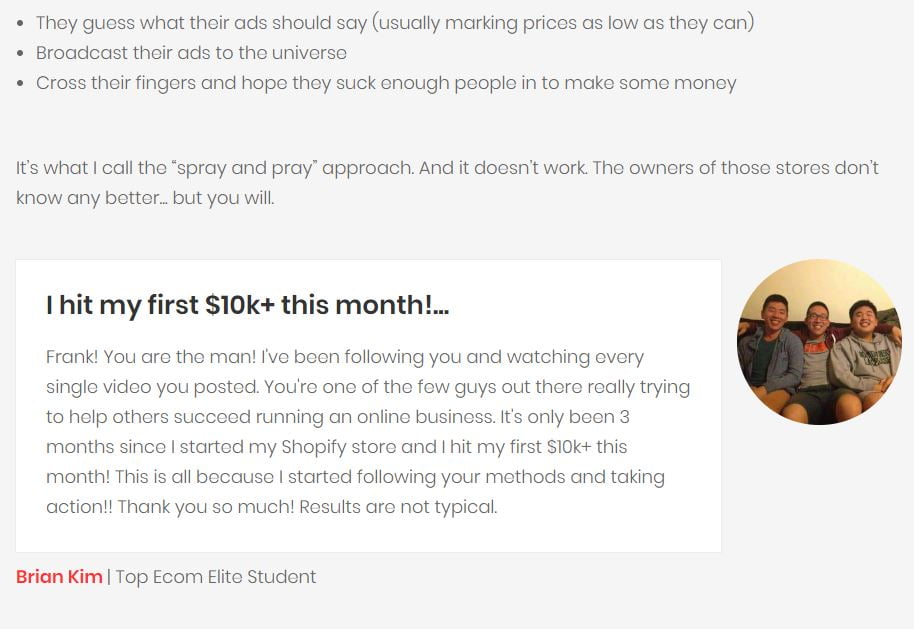
If others are making money through this course, interested customers will be more likely to buy as it relieves objections and worries.
It also gives them insight into what to expect using the product.
I recommend that you leverage reviews and testimonials as much as possible because of this.
Place them on any page where you want users to take action and convert.
5. A sense of urgency
Imagine you want to purchase a product.
But, here’s the problem…
There’s a countdown clock ticking away until the product is no longer available! 😱
You’d be moving fast as lightning to make sure you check out in time.
That’s what we call urgency. Another powerful copywriting psychological trigger.
It means that customers feel urgent to take action in fear that they will miss out on a deal.
Nick Hobson Ph.D. put it best by saying:
“You’ve been invited to go out for dinner and drinks with co-workers (the fun co-workers, not the annoying ones). But instead, you decide to stay back at the office to put in more work. Of course, you can’t help but wonder: what exactly are you missing out on? How much fun are they having without you there? Will there be inside jokes that you’re now not privy to?”
We’ve all felt it at some point. And, you should put it in your arsenal of tools to use.
Look how Nordstorm does this with their sales promotions:
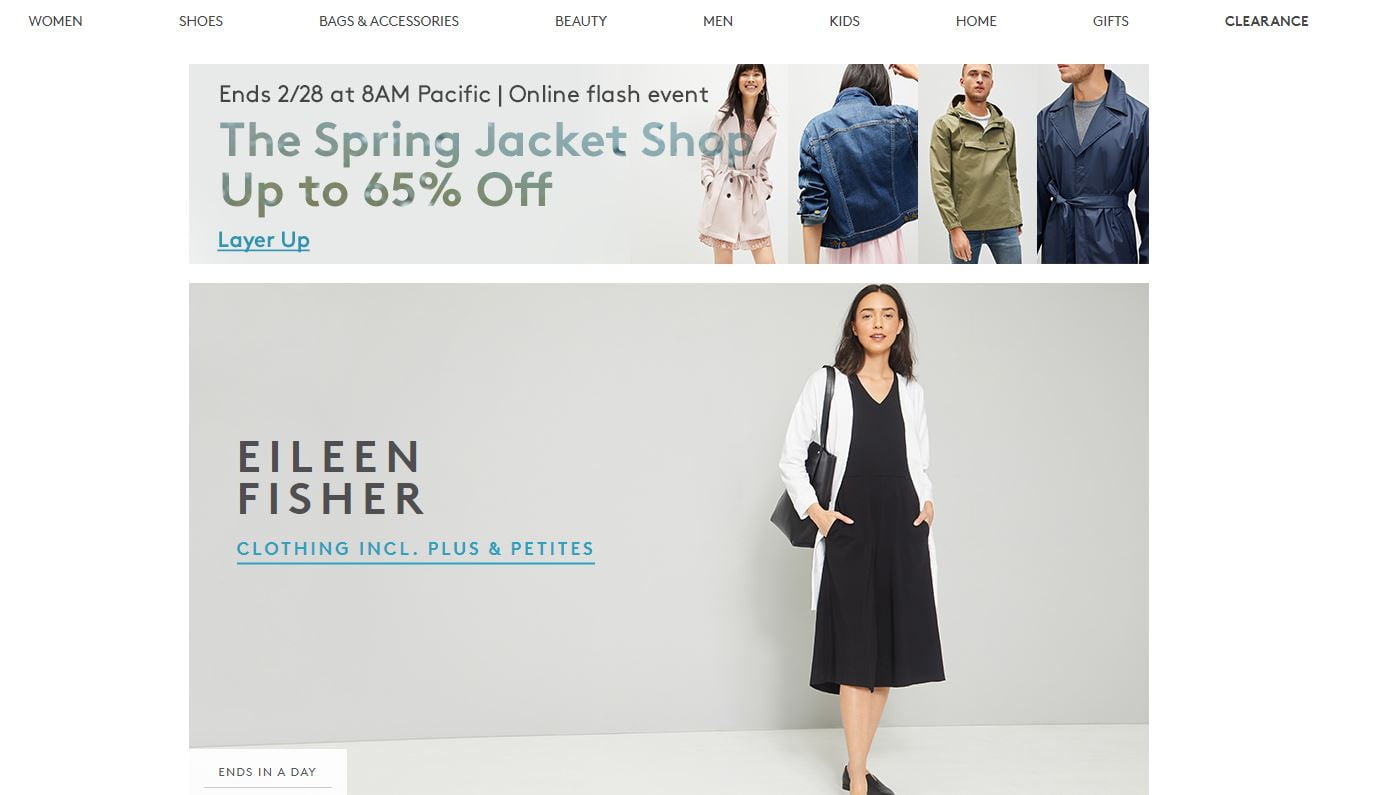
The first banner reads “Ends 2/28 at 8AM Pacific” and the second says “Ends In A Day”.
This will make users feel that they are going to miss out on a great opportunity if they don’t shop soon.
The key is to restrict the amount of time a customer can take action to purchase a product, use a discount code, etc.
Clearly state the benefit (like a discount) and when it will no longer be available.
That brings me to my next point.
6. Feast and famine (but specifically famine)
What’s the opposite of abundance?
Scarcity.
A.K.A lack or low supply of goods.
Similar to urgency, a sense of scarcity can make customers jump the gun and take action before they miss out.
This works perfectly for physical products because there may be limited supply, low inventory, or special editions.
Have you ever seen an ad that said: “While supply lasts”? You’ve seen this strategy then.
I use to wear Kappa all of the time as a kid, so here’s a cool example:

The official Kappa online store has a low inventory clearance page where customers can buy products that are nearly unavailable.
Let’s say you wanted those cool turquoise track pants.
Well, they’re not going to be around for long!
So, you have to buy them fast.
See how that works?
Copywriters can utilize this psychological trigger by clearly stating things like:
- Low inventory
- While supply lasts
- Clearance
- Low stock
- X left in stock
- Nearly sold out
- Etc.
7. Strategic storytelling
It’s like that Kermit the Frog meme.
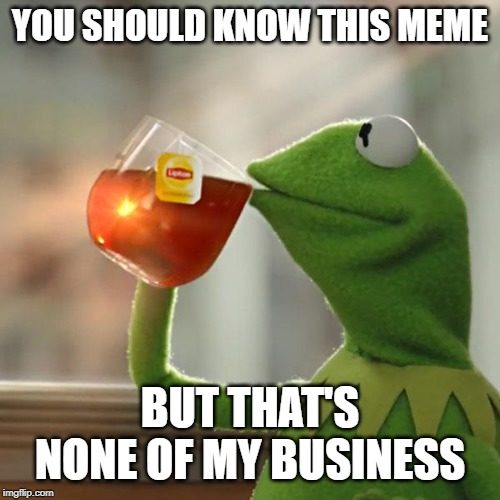
Everyone loves a little bit of tea. (Gossip.)
Heck, we evolved sitting around a fire telling stories.
So, it shouldn’t be a surprise that we love them equally today.
Storytelling goes all the way back to cavemen painting art on walls to Plato telling tales of Atlantis.
They are all about emotion, triumph, mystery, collaboration, and connection.
Stories help us imagine experiences as if they were real and generate behavioral responses.
In fact, stories engage the right side of the brain and release neurotransmitters like oxytocin which makes readers feel a connection to the storyteller.
With that being said, copywriters use storytelling to gain the reader’s attention, increase their emotions, and make them feel connected to the product.
Here’s a simple example:
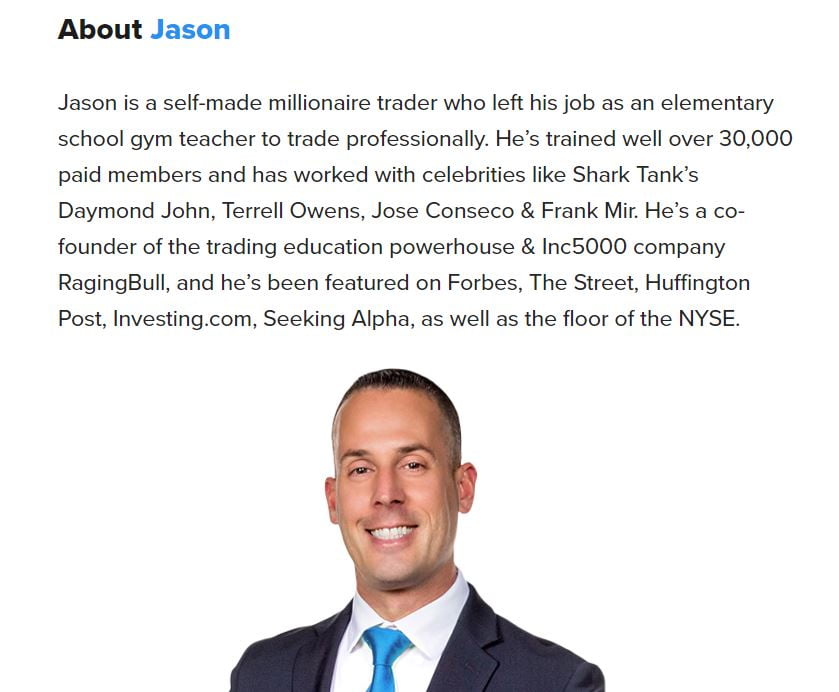
This is a quick blurb about an instructor who teaches a course on trading stocks.
Note how it explains he left his job as an elementary school gym teacher and become a self-made millionaire.
It also touches on his celebrity clients and other achievements.
There are many people who are working a job and would love to quit to make a living trading, so this short story offers hope and relief.
That’s the beauty of stories in copywriting, as well.
They can be a small paragraph or span many pages.
The goal is to help the reader see themselves in the story and generate emotion.
This helps warm them up to take action afterward.
8. Use active voice over passive to persuade more readers
One of the easiest wins to take in copywriting is replacing passive voice with active voice.
The subject is acted upon by the verb in passive voice while the subject performs the action in an active voice.
Let me give you an example:
- Active voice: She wrote amazing sales copy that impressed the client.
- Passive voice: The sales copy she wrote impressed the client.
A study from 2002 concluded that passive sentences weaken persuasion while active sentences increase processing fluency.
This means that readers can process your sales copy, the offer, and message which leads to more action and conversions!
It’s a small copywriting psychological trigger but one of the easiest to implement.
I recommend using a tool like Hemingway App to instantly find all of the passive sentences in an advertisement.

Simply paste in the copy and it will highlight passive voice.
Adjust this and your writing will instantly be better!
9. Get customers excited with future pacing from neuro-linguistic programming
If you haven’t read my guide to NLP copywriting, make sure to check that out after.
It will teach you the art of neurolinguistic programming and how you can mix it into your copywriting.
NLP is the science of understanding how words impact people’s behaviour.
You can probably see where I’m going with this.
One method in NLP is called future pacing.
This is the process of helping readers see an outcome before it happens.
As I talked earlier about visualization, this works in a very similar way.
By telling readers what they’re going to experience later (or to imagine it), we get them glued to the ad and feeling specific emotions.
You can use future pacing in two different ways. (Similar to my 10th point on copywriting psychology ahead.)
The first is to help the reader imagine themselves in the desired situation
…Away from their pain points.
…Away from what keeps them up at night.
Take a look at this headline written by Gary Halbert in an advertisement for a dentist.
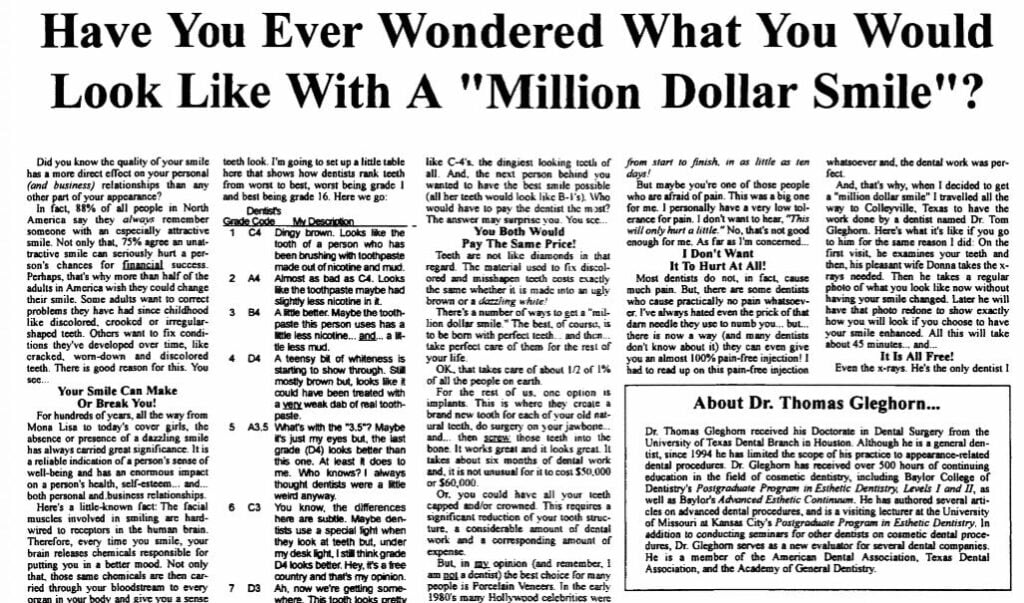
It reads, “Have You Ever Wondered What You Would Look Like With A Million Dollar Smile?”
Anyone that wants a better smile and is insecure about their teeth would read that, imagine having a nice set of pearly whites, and feel good emotions (more confidence, self esteem, etc.)
On the flip side, you can also use future pacing to warn people if they don’t take action they will be in an even worse spot.
For example, let’s imagine that we’re selling debt relief services.
We could write sales copy along the lines of, “Are you in crippling debt? Constantly worrying about debt collectors calling your phone? If you don’t fix your credit score and pay off your debt, things will only go downhill. You won’t be able to get loans for a car, home, or anything. You won’t be able to pay bills or sleep at night. Your health will spiral downward from the soul-crushing stress. Luckily, we have X, Y, Z to help you.”
That brings me to my next point.
10. Master the art of positive and negative framing
If you’ve been writing and studying sales copy for even a modest amount of time, you’ll notice something…
A lot of it seems negative.
We’re targeting people’s pain points, making them imagine unpleasant scenarios; you name it.
Why is this?
Simply because it works.
People purchase products with emotion and rationalize it with logic after.
They’re often trying to escape a certain situation, lifestyle, or feeling that a product or service can relieve.
This is what is called loss aversion in psychology—the human tendency to be more interested in preventing a loss than gaining the equivalent upside.

Framing sales copy as “negative” is very powerful because of this.
But, everything does have to be so glum.
Sales copy can (and should) be very positive at times and in certain areas.
For example, when you’re helping customers imagine their dream lifestyle, the benefits of a product, etc., it should be very positive.
Talk about how much better their life will be … the great feeling they’ll experience … why the product is so amazing and unique.
Find a delicate balance in advertisements of using negative and positive framing to elicit certain emotions in the prospect and guide them towards a solution.
11. Predict and overcome objections to prevent losing customers
People love buying things but they hate being sold.
Naturally, consumers are going to have some skepticism about your offer.
They aren’t going to whip out their credit cards and send you all of their money without some questions and friction.

These are called objections.
If you have experience in sales, you know what I’m talking about.
Consumers are going to object to many things including:
- Pricing
- Shipping
- Refunds
- Returns
- Quality
- Customer service
- Proof
- Credibility
- Etc.
It is your job as a copywriter to get into the head of your target audience and address these objections as/before they arise.
How do you do this?
A few different ways.
One is to collect primary research.
This includes surveys, questionnaires, and focus groups.
It’s data that you collect first-hand and nobody else has.
I talk more about this in my copywriting course Sell Like Hell if you’d like to 10x your writing skills.
Nonetheless, you can still perform secondary research.
This is the collection of public and pre-existing data which is perfectly fine in most cases.
I recommend collecting documents like:
- Buyer personas/ICPs
- Brand and content guidelines
- Past advertisements
- Testimonials, reviews, and case studies
- A list of competitors
Next, ask and answer the following questions:
- Who is my audience?
- What motivates them?
- What questions and objections do they have?
- What pain points are they trying to solve?
- What is the product?
- What are its features and benefits?
- What’s the value proposition?
After research and brainstorming, you’ll start to pick up on trends.
Perhaps your target audience wants to see more social proof, thinks competitors’ low prices are suspicious, and is curious about individual features.
Address these concerns within the sales copy and you can significantly increase conversions. 🚀
12. Bait them in with a mystery and curiosity
Do you know what’s one of the greatest motivators for consumers?
No, it’s not greed … fear … or envy.
It’s curiosity.
We love a good secret or mystery.
We want to know more when the whole story isn’t told.
It gets us at the edge of our seats wanting more.
You can take advantage of this copywriting psychological trigger as a marketer.
The key is to give most of the information away but retain something important.
You can use this method in headlines, introductions, and other areas of an advertisement to keep people reading.
Look at this ad written by legendary copywriter Eugene Schwartz for example.
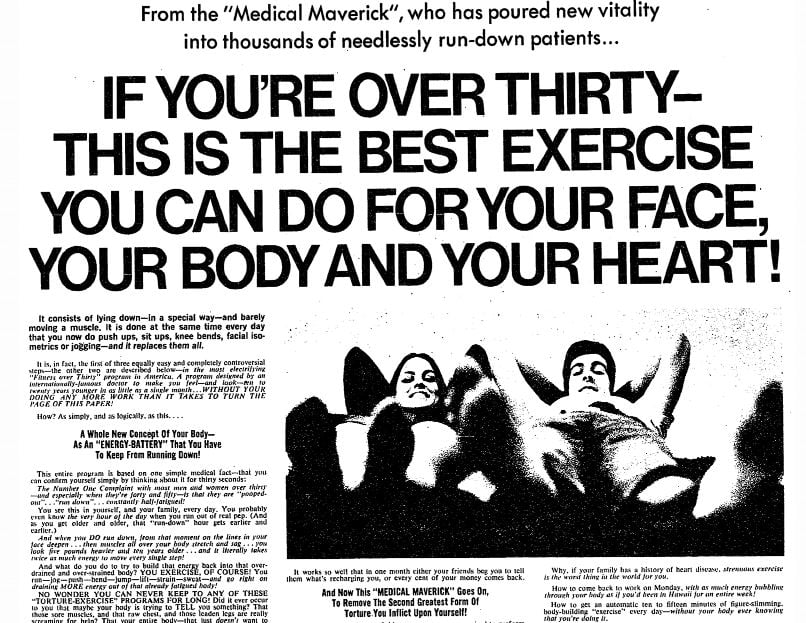
The prehead says, “From the Medical Maverick, who has poured new vitality into thousands of needlessly run-down patients…”
Who is this “Medical Maverick” and how have they helped thousands of people?
Then, the headline reads, “If You’re Over Thirty-This is The Best Exercise You Can Do For Your Face, Your Body and Your Heart!”
Note how they don’t tell you what the exercise is but explain who it’s for and the benefit of doing it.
People over 30 looking to get in shape will be thinking, “Hey, that’s me! But what’s the exercise? I guess I better read to find out.”
Final thoughts on the psychology of copywriting
Copywriting is part art, part psychology.
You need to use both or your words lose power.
It’s like pasta and tomato sauce. You need both!
There’s a skill to strategically using certain words, phrases, and strategies.
But, you need to know what makes customers tick and why, too.
These psychological triggers are used to increase engagement and campaign performance.
So, what are you waiting for? Try implementing the copywriting sales triggers you learned today.
If you need a copywriter to grow your business for you, reach out to me for a free consultation.














